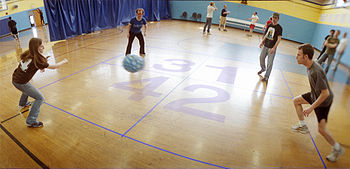Four Square

The layout of a four square court.
|
|
| Players | 4 |
|---|---|
| Setup time | 30 seconds |
| Skill(s) required |
Manual dexterity Strategy Social skills |
Four squareis a ball game played among four players on a square court divided into quadrants. It is a popular game at elementary schools with little required equipment, almost no setup, and short rounds of play that can be ended at any time.
Four square is usually played with a rubber playground ball, on a square court with four maximum players. The objective of four square is to eliminate other players to achieve the highest rank. A player is eliminated when a ball is bounced in a player's quadrant and the player is unable to touch the ball into another player's quadrant.
Four square is played on any hard-surfaced court, such as wood, concrete or asphalt. There is no official court size, but typically courts measure between 10 and 20 feet on a side, and divided into four smaller equal-size squares. Each of the four squares has a rank and is occupied by a single player. The ranks may be arranged so that either the highest ranking square is positioned facing the lowest ranking square, or the ranks increase as one moves clockwise (or counterclockwise).
The lines on the court are boundaries. The interior lines separating player squares are out of bounds. The ball may not touch any portion of an inside line or the player who hit the ball is in error. In recreational play, and even with a judge in tournament play, it is often difficult to determine if the ball hits the line.
The lines marking the outermost edges of the court are typically considered in-bounds. If a ball lands on or touches the inside lines then the last person to touch the ball is eliminated. These boundary rules are often described as "inside out, outside in."
Four square is played with a rubber playground ball, typically 8.5" diameter, and inflated to 2 lbs. However, other sizes and types of balls can also be used.
During regular play, or "classic," the ball must be hit with the player's hands only.
In classic play, carrying, catching, or holding the ball during play is not allowed, although putting spin on the ball is allowed as long as carrying does not occur. Prolonged contact with the ball can give players unfair control over the play. Hitting the ball must create a perceptible change in the ball's velocity (speed or direction).
Players may be eliminated from the court because of errors or fouls they commit. Eliminated players leave the court, the remaining players move up to the next highest square, and a new player joins the court in the lowest square. Eliminated players wait in line for their next turn.
The following actions may result in elimination (although many variations exist):
In recreational games, the highest ranking player, often known as the "king", may modify the game's rules at the beginning of each round. Many modifications either expand or constrain the legal methods of ball handling. Typically a player must "win" a point in the highest square before being able to invoke a new rule. Children refer to these modifications with elaborate local and regional nomenclatures.
...
Wikipedia
